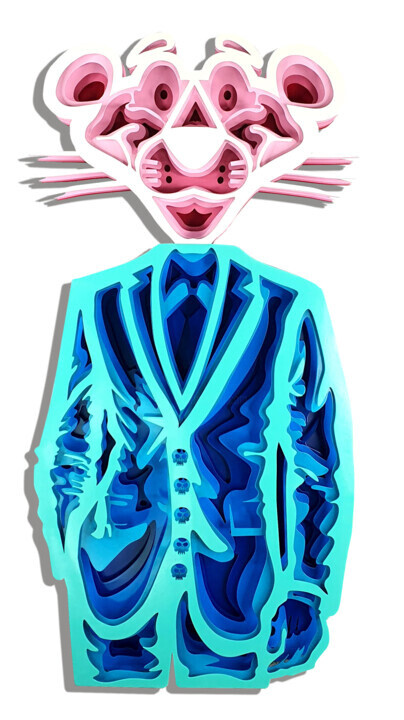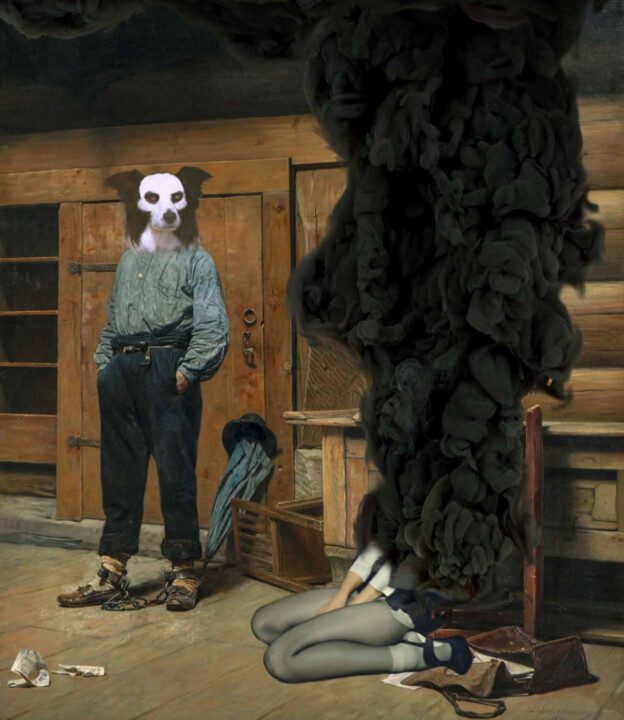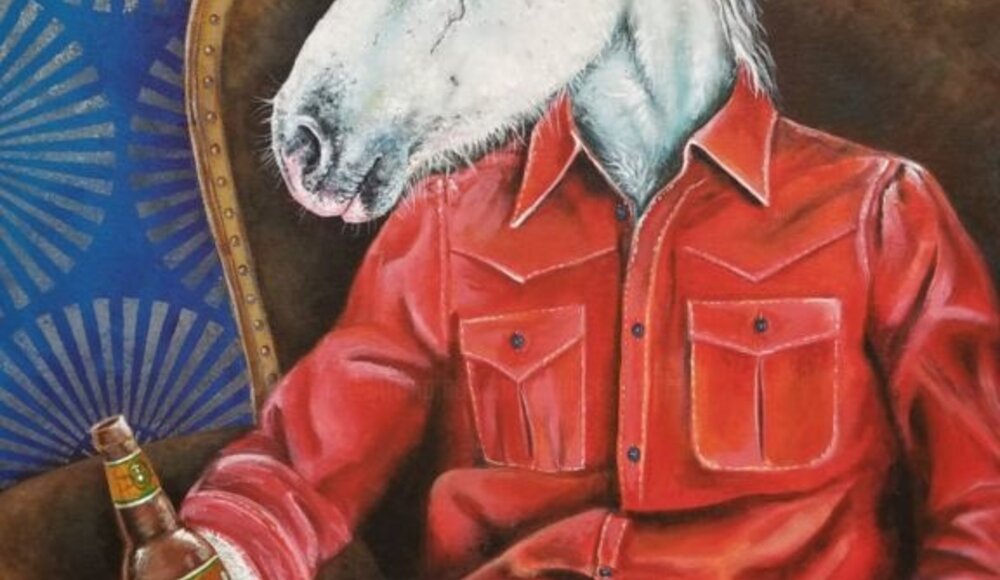 Pierre Lamblin, Mr. Panther, 2022. Painting on aluminum, 80 x 40 cm.
Pierre Lamblin, Mr. Panther, 2022. Painting on aluminum, 80 x 40 cm.
What is meant by anthropomorphism?
With the term anthropomorphism, a word derived from the two Greek words anthrōpos (human) and morphē (form), we indicate that particular way of attributing human characteristics and qualities to animate or inanimate beings, as well as to natural and supernatural phenomena, just like deities or protagonists of mythological tales. Such "enrichment" of the real datum, found, both in the artistic and literary spheres, has remote roots, so much so that in most ancient cultures fantastic narratives, paintings, bas-reliefs and statues can be detected in which we find anthropomorphic figures as protagonists.
 Cécile Duchêne Malissin, The metamorphosis IX, 2021. Acrylic on linen canvas, 92 x 73 cm.
Cécile Duchêne Malissin, The metamorphosis IX, 2021. Acrylic on linen canvas, 92 x 73 cm.
 Janice Serilla, Stormy is a brewin, 2018. Acrylic on canvas, 78.7 x 68.6 cm.
Janice Serilla, Stormy is a brewin, 2018. Acrylic on canvas, 78.7 x 68.6 cm.
Anthropomorphism in art
Anthropomorphism in art, as anticipated, boasts a rich and ancient tradition, in fact, among the earliest examples of anthropomorphic figures we find the Löwenmensch ivory statuette, which, dating back to the Upper Paleolithic, that is, approximately 32,000 years ago, depicts a human figure having the head of a lion. Speaking of ancient Egypt, on the other hand, it was this civilization that made anthropomorphism extremely popular, as anthropomorphization of deities became widespread after the Zoolatric period. An excellent example of this trend is the statue depicting Pharaoh Amenhotep III with the god Sobek, a deity, who, immortalized as a man having the head of a crocodile, represented the protector of the waters of the Nile and the fertility of the earth. The limestone alabaster sculpture, dating from the first half of the 14th century BCE, immortalizes the pharaoh and the god seated on a throne with the sides covered in hieroglyphics. In this particular context, it is good to highlight how Amenhotep III, looking very young, turns out to be smaller in size than Sobek, just as if the crocodile wanted to protect and accompany, and thus literally "escort," the ruler. Later, in terms of Greek and Roman art, the anthropomorphic character of the latter, although still present, became less pronounced, probably because the deities themselves were essentially people with supernatural powers. Nevertheless, we can take as an example the typical terracotta vases with anthropomorphic decorations made in the Greek Formative Period (12th-8th centuries B.C.), Hellenic Middle Ages in which the constituent features of Greek art and its main figurative types were delineated. Regarding the later Christian religion, it is undeniable how the latter found, over the centuries, a wide range of modes of representation of the Son of Man, among which, the symbols and allegories of Jesus depicted as the Lamb certainly stand out.
 Statue of Amenhotep III with the god Sobek, first half of 14th century BC. Limestone alabaster. Luxor: Museum of Ancient Egyptian Art.
Statue of Amenhotep III with the god Sobek, first half of 14th century BC. Limestone alabaster. Luxor: Museum of Ancient Egyptian Art.
 Giuseppe Arcimboldo, Summer, 1573 Oil on canvas, 76 x 64 cm. Paris: Louvre Museum.
Giuseppe Arcimboldo, Summer, 1573 Oil on canvas, 76 x 64 cm. Paris: Louvre Museum.
 Max Ernst, Attirement of the Bride, 1940. Oil on canvas, 129,6 x 96,3 cm. Venice: Peggy Guggenheim Collection.
Max Ernst, Attirement of the Bride, 1940. Oil on canvas, 129,6 x 96,3 cm. Venice: Peggy Guggenheim Collection.
Such allegorical-symbolic typology of anthropomorphism is well exemplified by the mosaic of the apse of the church Santa Maria in Trastevere (Rome), where, under the figures of Jesus and Mary, accompanied by Saints Peter, Cornelius, Julius, Calepodium, Calisto, Lawrence and the effigy of Innocent II, the Lamb of God is depicted in the midst of his sheep, that is, the twelve Apostles. Jumping forward in time by about four centuries, we are confronted with some of the best-known masterpieces in the history of art, which have been able to interpret, with great innovation, flair and uniqueness never seen before, the concept of anthropomorphism, just as in the case of Giuseppe Arcimboldo's iconic Summer (1573), an oil on panel painting preserved in the Louvre Museum. Indeed, within the famous painting, the abstract concept of the beautiful season comes to life, as well as human form, through an imaginative assemblage of summer fruits and vegetables. Another work that gave new forms to pictorial anthropomorphism was certainly Salvador Dali's The Anthropomorphic Cabinet, an oil painting, which, presenting a humanized piece of furniture, makes explicit reference to Sigmund Freud's thought that the human body consists of the multiple secret "drawers" of the unconscious. Finally, another artist who interpreted the concept of anthropomorphism in a very personal way was undoubtedly Max Ernst, a prolific avant-garde master distinguished by a particular fascination with birds, due to a rather dark incident in his childhood, in which his pet bird died just as his younger sister was born. Following this incident, the artist began to interpret birds as revealing omens of death; in fact, in the well-known painting the Attirement of the Bride, anthropomorphic bird figures appear, which, aimed at deceiving the viewer with their verisimilitude, take us into a parallel and distressing dimension, broadly associated with the atmosphere one breathes in the most disturbing nightmares.
 Manat, Paolo Verrocchio, 2022. Acrylic on canvas, 130 x 81 cm.
Manat, Paolo Verrocchio, 2022. Acrylic on canvas, 130 x 81 cm.
 Igor Skaletsky, Fantastic Mr. Dog, 2018. Acrylic on canvas, 115 x 100 cm.
Igor Skaletsky, Fantastic Mr. Dog, 2018. Acrylic on canvas, 115 x 100 cm.
Anthropomorphism in contemporary art
Speaking of the modern world, on the other hand, it seems evident that "classical" anthropomorphism has been largely enriched by experiments in the fields of film, advertising and television, in which, oftentimes, one encounters humanized animals or objects, just like the popular Mickey Mouse, Donald Duck and Bugs Bunny, but also the more recent BoJack Horseman, Spongebob and Kung Fu Panda. Returning to more traditional figurative arts, the aforementioned costume also continues to enjoy great success in painting, sculpture, and photography, just as the works of Artmajeur artists Eric Leroy (Rico), Katya Ivleva, and Dekoque demonstrate.
 Eric Leroy (Rico), The Thinker, 2022. Digital photograph / manipulated photograph on aluminum, 80 x 80 cm.
Eric Leroy (Rico), The Thinker, 2022. Digital photograph / manipulated photograph on aluminum, 80 x 80 cm.
Eric Leroy (Rico): The thinker
Eric Leroy's photograph immortalizes a puffer fish, which, having the body of a man, presents a posture intended to give an understanding of a state of deep psychological introspection, probably cased by those typical sad and heavy feelings with which humankind so often lives, estranged from its more animalistic, instinctive, spontaneous, and certainly less problematic nature. In reality, however, this innovative anthropomorphic work also carries additional meanings, as it represents a sympathetic "remake" of one of the greatest masterpieces in the history of 20th-century art: Auguste Rodin's The Thinker (1880). The sculpture in question depicts a naked man, who, seated on a pedestal with his torso tilted forward, rests his face against his left hand, while his right hand is instead "abandoned" on his thighs. The character, whose expression is mysteriously concealed behind his fingers, expresses, even through his intense body posture, an attitude of deep inner analysis. Therefore, it is thanks to the artist's contemporary interpretation of Artmjeur that one of the greatest introspective masterpieces is ironically revived in our time.
 Katya Ivleva, Bulldog in a jacket, 2021. Oil on canvas, 60 x 50 cm.
Katya Ivleva, Bulldog in a jacket, 2021. Oil on canvas, 60 x 50 cm.
Katya Ivleva: Bulldog in a jacket
Katya Ivleva's realist painting depicts a Bulldog whose expression, attitudes, and clothing totally anthropic, and which turns its gaze straight at the viewer, probably trying to propose itself as a kind of new, certainly much less compromised, model of humankind. Referring to the artist's own words, the work, part of the series Animals are also people, was inspired by the amusing, and at the same time "tragic", television series Horse Bojack, characterized by the coexistence of human characters with anthropomorphic animals. In addition, however, Ivleva is keen to point out that her portraits also present some ambiguities, as someone may recognize in the faces of the humanized animals both himself and his pet. In fact, main models for the creation of these anthropomorphic paintings are mainly the furry animals of the artist's friends and acquaintances. Finally, as far as art history is concerned, an iconic work having particular "civilized" subjects turns out to be Cassius Marcellus Coolidge's well-known masterpiece, A Friend in Need (1903), in which dogs play poker like real men.
 Dekoque, Powerful, 2022. Sculpture on metal, 21 x 37 cm / 3.00 kg.
Dekoque, Powerful, 2022. Sculpture on metal, 21 x 37 cm / 3.00 kg.
Dekoque: Powerful
Dekoque's sculpture reveals another face of anthropomorphism, namely its ability to attribute human characteristics and qualities even to inanimate beings, as in this case a hammer, probably intent on impersonating the likeness of a distressed worker in a jacket. In fact, on the base of the sculpture we find a nail, a likely allusion to the primarily performed task of the said tool. On the subject of art history, the Artmajeur sculptor's work lies within a solid contemporary anthropomorphic tradition, exhaustively exemplified by the figurative investigation of British artist and illustrator Jonathan Wolstenholme, who, a surrealist lover of ancient volumes, has animated his books by transforming them into clever anthropomorphic images.


 Olimpia Gaia Martinelli
Olimpia Gaia Martinelli























